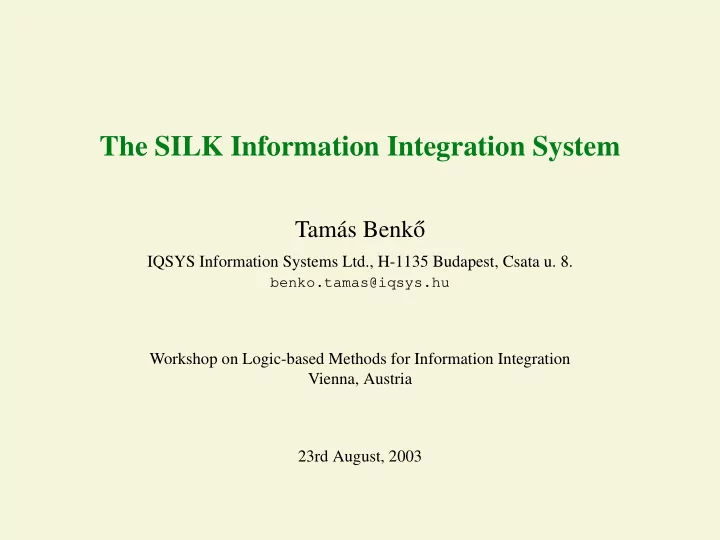

The SILK Information Integration System Tamás Benk˝ o IQSYS Information Systems Ltd., H-1135 Budapest, Csata u. 8. benko.tamas@iqsys.hu Workshop on Logic-based Methods for Information Integration Vienna, Austria 23rd August, 2003
Contents • SILK overview • Functionality and architecture • Model Warehouse • SILan semantics • SILan example • Reasoning capabilities • Future work
SILK: System Integration using Logic and Knowledge • An IST, EU 5th Framework programme project • Partners – IQSOFT Ltd. (Hungary) – EADS Systems & Defence Electronics (France) – National Institute for Research and Development in Informatics (Rumania) – Industrial Development and Education Centre (Greece) • Product: a tool-set for the integration of heterogeneous information sources – Integrator : building integrated models and customised user views – Mediator : querying on multiple sources and multiple abstraction levels – Wrappers : common interface for accessing various information source types ∗ relational and object-oriented databases ∗ semi-structured sources (e.g., XML, RDF) ∗ data provided through applications (e.g., Web-services)
The Context of SILK
SILK Functionality • store meta-data, access data on the fly – single information source view – data location transparency – no restriction on the type and structure of the information • modelling solution – import, modify, export object-oriented models – establish mappings between models – compose queries (and export query results) • reasoning capabilities – model comparison – model (in)consistency checking – model unification – query and mapping composition support
SILK Architecture
Structure of the Model Warehouse
Components of the Model Warehouse • Models (UML class diagrams) – local : model of single system or a user view – unified : model covering several other models • Mappings (OCL constraints) – correspondence : constraint linking model elements on the same level of ab- straction – abstraction : constraint linking model elements on different levels of abstraction • Queries (SQL with OCL expressions)
SILK modelling example Model semantics • class : set of instances model Factory { class Product { • association : set of links attribute String serial; primary key serial; • attribute : function from the class to }; the type of the attribute class Car: Product { • operation : function from the product attribute String make; of the class and the domains of the pa- attribute Integer price; rameters to the type of the operation constraint self.wheel.size>2; }; • connection : end-point of an associa- tion class Wheel: Product { • inheritance : derived class is the sub- attribute Integer size; set of the base class }; • primary key : a set of attributes uniquely association ’Car-Wheel’ { identifying an instance of a class connection Car; connection Wheel composite; • constraint : an invariant for all instances }; of a class or links of an association };
Mapping example (an abstraction) abstraction (s: Peugeot::Vehicle -> c: Factory::Car) { constraint s.type = "Car" implies s.serial_number = c.serial and "Peugeot" = c.make and s.price*1000 = c.price; }; • abstractions give the necessary rules to create new instances (links) of classes (asso- ciations) • suppliers : the sources of the information (here s ) • clients : the new instances or links (here c ) • in this case we create “abstract” cars from Peugeot vehicles of type Car • OCL constraints for necessary conditions ( s.type = "Car" ) and conversions ( s.price*1000 = c.price )
Mediator Logical Language • A simple and uniform representation of the contents (both structural properties and constraints) of the Model Warehouse • A set of Description Rules of the form ∀ X. ( p 0 ( X 0 ) ∧ . . . → ∃ Z.q 0 ( Y 0 ) ∧ . . . ) where X = � i X i , Y = � i Y i , and Z = Y \ X . • Quantification is implicit Example: Abstraction The condition consists of the existence of the suppliers in conjunction with the condition part of the top-level implies (if any). The consequent part is the right hand side of the top-level implies ’Vehicle’(SNo,’Car’,Price) ---> ’Car’(SNo,’Peugeot’,CPrice), CPrice = 1000*Price
Model comparison Task • Find and connect similar elements in two sets of model elements. • Mathematically: compare two graphs with different kinds of nodes and leaves. Functionality • compare models – on the same or on different levels of abstraction – with a mix of UML and DL constructs • connect matching elements by links • label links with default constraints (to be refined by the Integration Engineer e.g., by using Mapping Designer)
Result of using the Mapping Designer
Model verification Task • check model elements for inconsistency • provide explanation for the inconsistency Functionality • convert OCL constraints and UML structure to first order logic • check classes and associations for emptiness • check correspondences and abstractions for satisfiability • work solely on the meta level, i.e., without considering the data in the information sources
Model unification Task • combine several models into a new one • link the old and new elements to facilitate mediation Functionality • create new model elements • according to unification policy (e.g., create the union or the intersection of models being unified) • taking into account correspondences • introducing default abstractions
Future work Complete DL (Description Logic) support • extend the RDF support to DL support • support DL on all levels of SILK Tighter J2EE coupling • integrate into J2EE application servers • provide standard J2EE communication interfaces Develop an agent architecture • make the communication with SILK easier for mobile applications • make SILK-components more autonomous
Recommend
More recommend